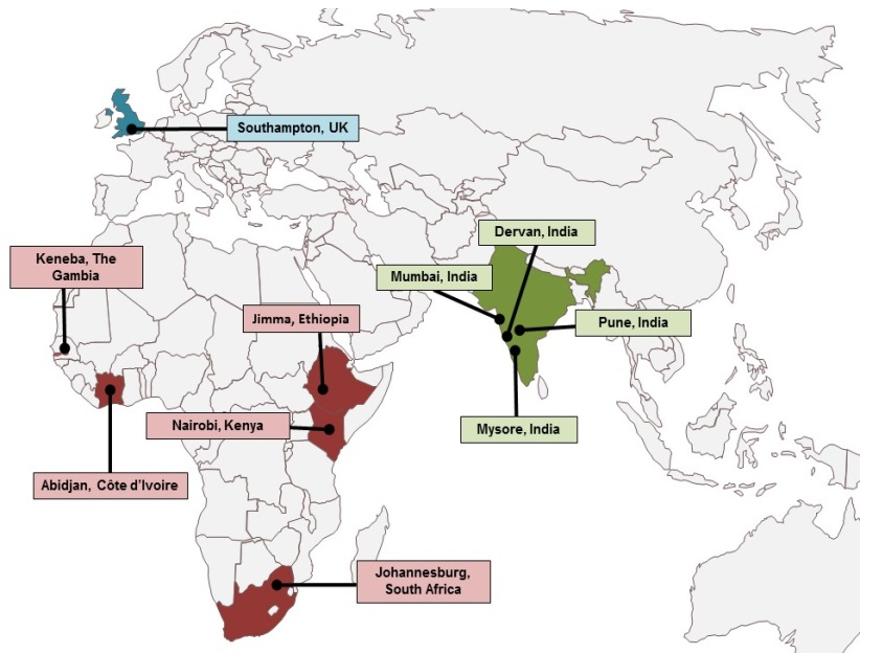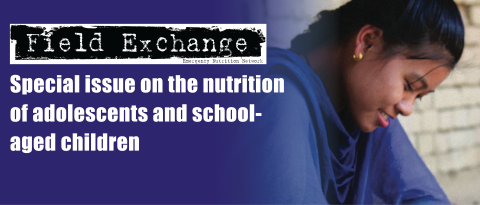TALENT Collaboration: Exploring adolescent diet and physical activity in India and sub-Saharan Africa.
By Polly Hardy-Johnson, Susie Weller, Sarah Helen Kehoe, Mary Barker, Abraham Haileamalak, Landing Jarju, Julie Jesson, GV Krishnaveni, Kalyanaraman Kumaran, Valeriane Leroy, Sophie Moore, Shane A Norris, Suvarna Patil, Sirazul Sahariah, Kate Ward, Chittaranjan Yajnik and Caroline Fall on behalf of the TALENT collaboration.
The TALENT collaboration also includes Ulka Banavali (BKL Walawalkar Hospital, India), Edna Bosire (University of the Witwatersrand, South Africa), Harsha Chopra (Centre for the Study of Social Change, India), Meera Gandhi (Centre for the Study of Social Change, India), Ramatoulie Janha (MRC Keneba, MRC Unit The Gambia), Shama Joseph (CSI Holdsworth Memorial Hospital, India), Kejal Joshi Reddy (KEM Hospital, India), Elizabeth Kimani-Murage (African Population and Health Research Center (APHRC), Kenya), Egnon Kouakou (PAC-CI, Ivory Coast), Mubarek Abera Mengistie (Jimma University, Ethiopia), Stephanie Wrottesley (University of the Witwatersrand, South Africa) and Pallavi Yajnik (KEM Hospital, India).
The authors would like to acknowledge their funders, the Global Challenges Research Fund and the University of Southampton Global Challenges Research Fund.
Location: Cote D’Ivoire, Ethiopia, India, South Africa and The Gambia.
What this article is about: This article describes the findings from the TALENT Consortium stakeholder engagement, survey and focus group discussions regarding adolescent diet, physical activity and health.
Key messages:
- The study found that all adolescents knew about healthy lifestyles but a range of other factors often led them to make unhealthy choices.
- Food choices and opportunities to engage in physical activity differed between rural, urban and peri-urban areas and were sometimes area of conflicts between adolescents and parents/caregivers.
- Interventions to improve adolescent diet and physical activity need to be context-specific and responsive to changing environments.
Background
The Transforming Adolescent LivEs Through NutriTion (TALENT) Consortium, established in 2018, comprises biomedical scientists (epidemiology, nutrition, laboratory science, intervention development), social scientists (psychology, sociology, social geography) and experts in policy and public engagement from the United Kingdom, four African countries (Cote d’Ivoire, Ethiopia, South Africa and The Gambia) and four locations in India (Dervan, Pune, Mumbai and Mysore) (Figure 1). TALENT includes eight sites (in five different low- and middle-income countries (LMICs)) at different stages of economic and nutrition transition. TALENT recruited participants from both rural (Dervan in India and Keneba in The Gambia), urban (Abidjan in Cote D’Ivoire, Mumbai in India, Mysore in India and Soweto in South Africa) and peri-urban (Jimma in Ethiopia and Pune in India) settings (Figure 1). TALENT aimed to share expertise and build capacity amongst biomedical researchers in qualitative research through training and mentorship and by leveraging local funding. A further aim was to provide new insights into ways to address the double burden of malnutrition amongst adolescents living in LMICs by affording opportunities for young people to discuss their own lived experiences and views of diet and physical activity.
Figure 1: TALENT collaborating sites

Methodology
A series of stakeholder engagement sessions, survey data collection and focus groups was conducted to answer the following research questions:
- What do young people and parents/caregivers think about diet, physical activity and health and how important are these to them?
- What and who decides and shapes their eating and activity habits?
- What might engage adolescents in changing their diet and physical activity?
The qualitative research was conducted by local researchers already embedded in each setting. Focus groups were conducted with 480 adolescents and their parents/caregivers using creative techniques such as a photograph sorting activity where adolescents were invited to categorise different food types. The views of parents/caregivers were also sought as we considered these to be important in understanding the challenges and for developing solutions. In addition to the qualitative data collection, we collected small-scale contextual quantitative data from approximately 40 boys and 40 girls in each site (Fall et al., 2020). We used surveys to generate data on adolescent diet, body composition and socioeconomic status. Three systematic reviews were also conducted, including one qualitative evidence synthesis (Wrottesley et al, 2020; Jesson et al, 2020; Hardy-Johnson et al, 2021).
Main Findings
The qualitative research captured rich and nuanced data on adolescents’ everyday lived experiences. It highlighted the complexity of diet and physical activity influences and demonstrated the importance of the broader contexts and processes that shape adolescent health in transitioning societies. A cross-site analysis of the pooled qualitative data (Weller et al, 2020) identified three themes.
The first theme focused on transitions in generational nutrition education and knowledge. Adolescents, even in resource-poor settings, knew about healthy diets and lifestyles. They wanted to have energy, feel happy, look good and live longer but their desire for autonomy, a need to ‘belong’ in their peer group, plus vulnerability to marketing campaigns that exploited their aspirations, often led them to make unhealthy choices. Across all sites, participants displayed a good level of nutritional knowledge that was often underestimated by parents/caregivers who felt it was their job to educate their young people on such matters.
The second theme, transition in caregiver– adolescent power balance, described how adolescents and caregivers discussed power imbalances related to diet and physical activity. In the more urbanised settings, both adolescents and caregivers described the frequent negotiations and, in some instances, conflict that would occur regarding food options/choices and physical activity. For example, in Mumbai, caregivers expressed immense frustration that their children preferred ‘outside’ junk food to their home-cooked ‘healthy’ food. In contrast, adolescents felt constrained by their parents and expressed joy in the social element of eating outside food with their friends. In Indian sites such as Mysore, adolescents described pressure from adults to excel in exams which meant that academic studies often squeezed out physical activity time.
The final theme, the implications of societal and economic transition for diet and physical activity, depicts the differences between the rural and urban sites in relation to food choice and the opportunities to engage in physical activity. For example, urban adolescents in sites such as Soweto had easy access to calorie-dense, unhealthy foods bought outside the home whereas junk foods were only beginning to permeate rural sites such as Keneba. Across the sites, it was clear that rural and urban transition influenced the types of foods that were available, where those from more urbanised sites had more choice.
The data generated far exceeded expectations; 13 journal articles have been published on adolescent nutrition in LMICs. The added value produced from this relatively small award is a testament to the extraordinary collaboration we have established.
Next steps
Through TALENT, primary investigators and early career researchers have been trained in qualitative methods and now have experience in applying social science methodologies to the study of adolescent nutrition. The TALENT teams are keen to use these newly developed skills to develop interventions to improve adolescent nutrition which will need to be context-specific and responsive to transitions at the individual, economic and societal levels. Solutions need to acknowledge gender inequalities in different contexts and structural and cultural influences on diet and physical activity in resource-limited settings. Programmes need to be effective in engaging and reconciling the perspectives of adolescents and caregivers. Consequently, there is a need for action at both the community household level and through policy. In the next phase of work, the TALENT Consortium will use community engagement and participatory research techniques by employing groups of adolescents to develop and implement interventions to improve adolescent nutritional status.
Find out more information about TALENT through Twitter @GCRF_TALENT and TALENT publications.
For more information about this article, please contact Polly Hardy-Johnson at phj@mrc.soton.ac.uk
References
Abera, M, Hardy-Johnson, P, Abdissa, A, Workicho, A, Ali, R, Weller, S and Haileamlak, A (2020) Social, economic and cultural influences on adolescent nutrition and physical activity in Jimma, Ethiopia: perspectives from adolescents and their caregivers. Public Health Nutrition, 1-9.
Banavali, U, Patil, S, Chavan, R, Sonawane, S, Joglekar, C, Fall, C and Hardy-Johnson, P (2020) What shapes adolescents’ diet and physical activity habits in rural Konkan, India? Adolescents’ and caregivers’ perspectives. Public Health Nutrition, 1-10.
Barker, ME, Hardy-Johnson, P, Weller, S, Haileamalak, A, Jarju, L, Jesson, J and Fall, CHD (2020) How do we improve adolescent diet and physical activity in India and sub-Saharan Africa? Findings from the Transforming Adolescent Lives through Nutrition (TALENT) consortium. Public Health Nutrition, 1-9.
Chopra, HV, Gandhi, MJ, Sahariah, SA, Weller, S, Potdar, RD, Barker, M and Hardy-Johnson, P (2020) Conflicts between adolescents and their caregivers living in slums of Mumbai, India in relation to junk food consumption and physical activity. Public Health Nutrition, 1-11.
Fall, CH, Abera, M, Chopra, H, Hardy-Johnson, P, Janha, RE, Jesson, J and Barker, ME (2020) Anthropometric nutritional status, and social and dietary characteristics of African and Indian adolescents taking part in the TALENT (Transforming Adolescent Lives through Nutrition) qualitative study. Public Health Nutrition, 1-12.
Hardy-Johnson, P, Dhuria, P, Strommer, S, Weller, S, Barker, M and Fall, CH (2021) Exploring the diet and physical activity behaviours of adolescents living in India and sub-Saharan Africa: a qualitative evidence synthesis. Public Health Nutrition, 1-11.
Janha, RE, Hardy-Johnson, P, Kehoe, SH, Mendy, MB, Camara, I, Jarjou, L, Ward, K, Moore, SE, Fall, C, Barker, M and Weller, S (2020) Exploring influences on adolescent diet and physical activity in rural Gambia, West Africa: food insecurity, culture and the natural environment. Public Health Nutrition, 1-11.
Jesson, J, Kouakou, EK, Hardy-Johnson, P, Ngoran-Theckly, P, Kehoe, SH, Adonis, L and Weller, S (2020) Adolescent nutrition and physical activity in low-income suburbs of Abidjan, Côte d’lvoire: the gap between knowledge, aspirations and possibilities. Public Health Nutrition, 1-11.
Joshi-Reddy, K, Kamble, V, Kunte, P, Hardy-Johnson, P, Fall, CH, Barker, M and Kehoe, SH (2020) Adolescent diet and physical activity in the context of economic, social and nutrition transition in rural Maharashtra, India: a qualitative study. Public Health Nutrition, 1-10.
Weller, S, Hardy-Johnson, P, Strommer, S, Fall, C, Banavali, U, Chopra, H and Barker, M (2020) ‘I should be disease free, healthy and be happy in whatever I do’: a cross-country analysis of drivers of adolescent diet and physical activity in different low-and middle-income contexts. Public Health Nutrition, 1-11.
Wrottesley, SV, Bosire, EN, Mukoma, G, Motlhatlhedi, M, Mabena, G, Barker, M and Norris, SA (2019) Age and gender influence healthy eating and physical activity behaviours in South African adolescents and their caregivers: Transforming Adolescent Lives through Nutrition Initiative (TALENT). Public health nutrition, 1-20.


